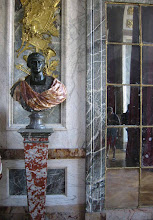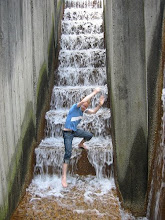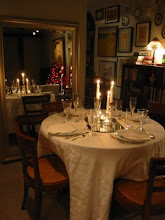One of my favorite architectural monuments anywhere is the Palace of Fine Arts in San Francisco. I find myself visiting this location every time I'm in the city.
Built in 1915 for the Panama-Pacific International Exposition the structure was intended to only be temporary.
However it proved to be so popular it was left standing long after the exposition thanks to Phoebe Hearst.
By 1965 the 'temporary' nature of the materials was evident and the palace was in ruins. It was torn down and rebuilt of steel and lightweight concrete. Later still it was reinforced for earthquakes.
Originally designed by local architect Bernard Maybeck the structure is a fantasy of Greek and Roman architecture.
I've always wondered what these women statues were looking at!
The detail work is still crisp and beautiful.
Notice the scale: it's so immense that people look like ants and barely show up in photographs! As always you can click on the photos to view them larger.
I wish these stepped planters were in use -it would look phenomenal with creeping vines, boxwood, rosebushes, etc.
You probably recognize the Palace of Fine Arts from numerous fashion shoots and advertisements. I remember a lot of car advertisements from the 70s and 80s.
The interior of the dome is no less grand.
Again notice the scale of the urns -the door to the lower right hand corner above is probably 7'-0" tall and has a transom over it.
The Palace of Fine Arts sits in the Marina district -a residential neighborhood. Those are some lucky houses with quite the view!
We were lucky to have a gorgeous day to wander around the marina and the Palace of Fine Arts. It's rather remote away from other touristy areas so never seems to be too crowded in my limited experience.
If you find yourself in San Francisco make sure to visit the Palace of Fine Arts in the Marina District, you won't regret it!
Showing posts with label exteriors. Show all posts
Showing posts with label exteriors. Show all posts
Thursday, July 3, 2014
Wednesday, May 29, 2013
A hidden Venetian garden
My Australian penpal, Neil, has been traveling again, this time to Italy. He sent me photos of this hidden garden in Venice that I just had to share with you!
The Palazzo Soranzo Cappello dates to the late 16th century and now houses the architecture authority for Venice, Belluno, Padua, and Treviso.
The house is beautiful but it's the garden that steals the show.
This classical folly anchors the end of a lush, green garden.
A closeup reveals a brick structure with worn stucco covering to appear as stone.
I love the Italian mindset as to preservation (the Palazzo was recently restored); Let it look old, it doesn't need to look brand new like in Paris.
Maybe it's the architect in me but I need some sort of architectural anchor to give a garden interest.
Aren't these blooms spectacular?
You would never guess this was in the heart of Venice!
Perfect spot for a picnic.
The gardens are open to the public during office hours.
Be sure to check it out on your next Venetian getaway!
The Palazzo Soranzo Cappello dates to the late 16th century and now houses the architecture authority for Venice, Belluno, Padua, and Treviso.
The house is beautiful but it's the garden that steals the show.
This classical folly anchors the end of a lush, green garden.
A closeup reveals a brick structure with worn stucco covering to appear as stone.
I love the Italian mindset as to preservation (the Palazzo was recently restored); Let it look old, it doesn't need to look brand new like in Paris.
Maybe it's the architect in me but I need some sort of architectural anchor to give a garden interest.
Aren't these blooms spectacular?
You would never guess this was in the heart of Venice!
Perfect spot for a picnic.
The gardens are open to the public during office hours.
Be sure to check it out on your next Venetian getaway!
Wednesday, February 27, 2013
Posh Pockets of DC
While wandering around the city this past weekend I visited one of my favorite little pockets of the city, hidden in plain sight. You know what I mean when I say pocket of course; A small separate but unexpected area set within a different neighborhood.

This pocket in particular has retained an aire of exclusivity despite being nestled into a neighborhood recently known more for prostitution and drugs than affluent housing; the epicenter of such a crime zone in fact. Not one but two houses (mansions really) designed by my favorite architect, John Russell Pope, reside cheek to jowl across from one of the most beautiful Coop buildings in the city.
At the time these residences were built of course, the early 1910s till mid 1920s, this area of the city was one of the most exclusive residential neighborhoods in the city. Many of these fine houses still exist although in somewhat dire circumstances as embassies and apartment houses in shabby condition. However this one hidden pocket along a one way street has remained the lair of wealth.

Pope designed the first house seen here in 1925 for Irwin Laughlin in the Louis XVI style. Oddly enough, Laughlin was from my hometown of Pittsburgh and the grandson of one of the founders of the Jones and Laughlin Steel Company (you may remember I wrote about the Jones mansions in Pittsburgh at an earlier date). The neighboring house was built earlier in 1912 for Henry White - both houses now function as headquarters for the same organization.
At the same time as the Laughlin residence was being completed in 1925, a grand apartment building was being designed directly across the street by Joseph Younger in Georgian Revival style. City living, where else could your mansion be directly located across the street from apartments (admittedly the poshest apartments of their kind).
This glorious buildings features many of my favorite apartments in the city and rarely come up for sale: wood burning fireplaces, up to 4 bedrooms and grand entertaining spaces are not easy to find in Washington real estate.The building is detailed as finely as the Pope mansions across the street: important as these apartments originally sold for higher square footage costs than those very houses!
The original elevator has been lovingly retained (albeit with new mechanical systems) and is identical to the one in my own building built at the same time period. However, they have cleverly stripped the paint from the metal -allowing the classical design of industrial materials to shine through.
Photos taken with my iphone, select and click to enlarge.
Labels:
architects,
DC,
exteriors,
gardens.,
houses,
Washington
Subscribe to:
Posts (Atom)













































































.JPG)







































































